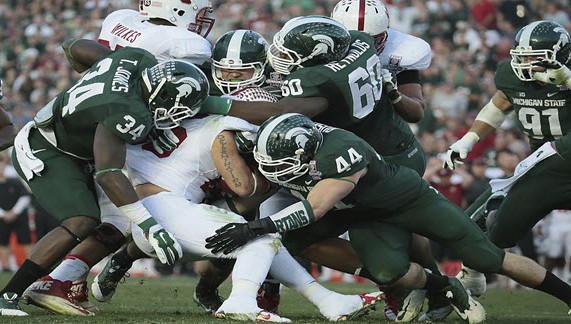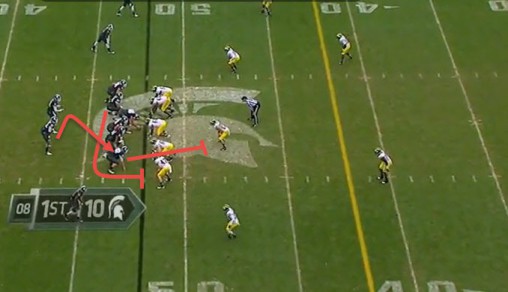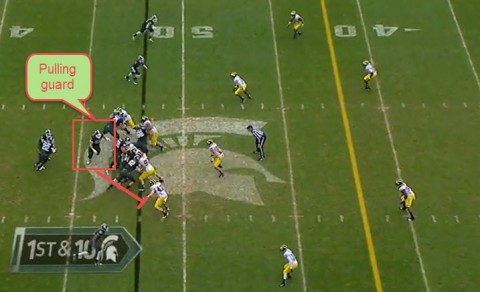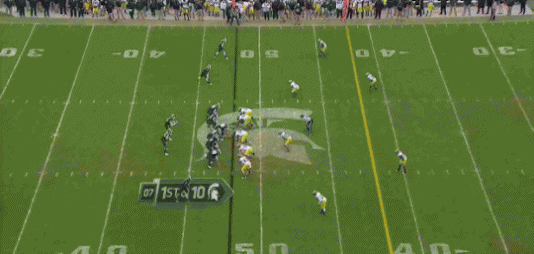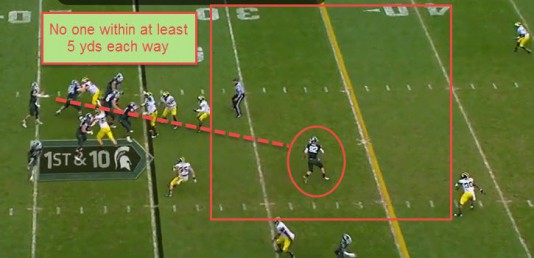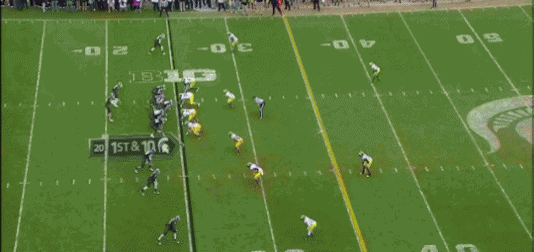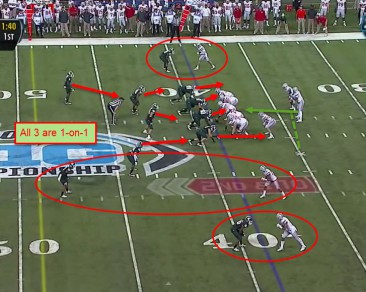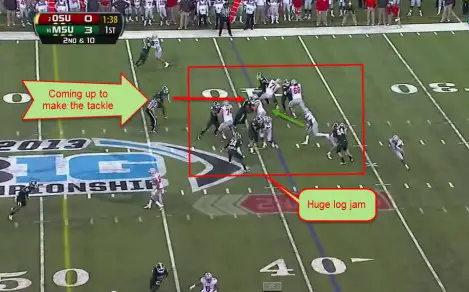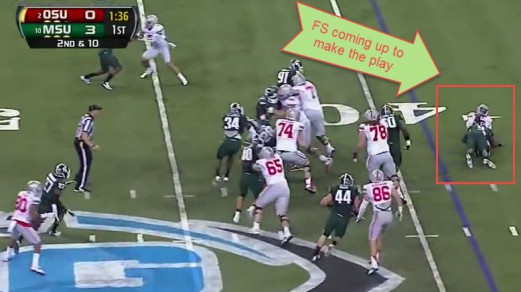The excitement for Duck fans is rising by the hour, as they get ready to welcome one of the biggest non-conference regular season games in Duck history! It is the first Top-10 match-up of the college football season, and will have an immediate impact on the inaugural College Football Playoff picture.
Both Oregon and Michigan State are appearing regularly in analysts’ playoff predictions; the winner will be in the driver’s seat for a spot in the playoffs, and the loser will have a tough time climbing back into the vehicle. But to better understand the game, a closer look at the Spartans is required.
Michigan State is a run-first team with a defense that is suffocating — similar to Stanford, whom they beat in the 2014 Rose Bowl. Offensively, despite the fact that their opponents always gear up to stop the run, the Spartans still find success due to their ability to be versatile in their formations. For example, we see how MSU runs a halfback draw against Michigan on 1st-and-10 (below). The goal of this play is to gain a solid 4-6 yards so that no matter the result of the second-down play, third down will be manageable.
For any team, this clearly is a passing formation (above), but MSU likes to run counters and other “out-of-the-ordinary” plays to keep the defense from cheating. So, as Michigan is lined up in a 4-3 Over formation, the MSU linemen now know who they are going to block.
A draw is a slow-developing play, and there are a couple of key components that the Spartans execute extremely well. The left tackle shows pass block, to keep the defender from going after the running back and the left guard is immediately pulling and blocking the outside linebacker, while the three other players on the line are blocking down.
This creates a hole big enough for the running back to squeeze through and gain four yards to create a very manageable second and third downs. Thanks to the discipline of the MSU line, the Michigan linebackers bit just enough on the pass fake to allow for a quality gain on first down.
On the very next drive, Mark Dantonio shows why he is one of the best coaches in the nation. As seen above, on 1st-and-10 at their own 25, MSU comes out with a very similar set to the one above. Despite the slight change in formation, defenses would still think pass first, but Michigan is left guessing.
Just a drive earlier, the Spartans ran for a sizable gain from nearly the same formation. To add to the Michigan dilemma, at the snap, the Spartans run a play action to the running back with the MSU right guard pulling as if it’s a run. All the while, Michigan is playing Cover 4.
The key to a Cover 4 is ensuring that the linebackers don’t bite on play-actions, as their failure to be disciplined will result in a wide open field, from sideline to sideline, spanning five yards and more – wide enough for a 747 to land.
MSU, though, is too good at executing their offensive plays. The linebackers bite just enough on the play action to open a gaping hole for an easy pitch and catch between the quarterback and the tight end, who is running what some call a “search route.”
This ends up being useful. A search route helps against zone coverage as the player, in this case the tight end, runs a seam route until he gets behind the linebackers. After he gets behind them he turns and keeps running, but he is always looking for the ball, as the quarterback can throw it in his direction at any time. Despite the seemingly flawless execution by MSU, the play results in an incomplete pass because Josiah Price, at least on this play, drops the easy pass.
This, of course, is not the point. Had the tight end not rubbed butter on his hands before the play, the result would have been an easy first down and gain of at least 13, and nine times out of 10 that pass will be completed and is an area to watch for against Michigan State.
Now let’s learn about how MSU has stopped the read option in the past. As you see in the screenshot above, the Ohio State running back actually started in the slot and then motioned into the backfield. This is almost a guaranteed sign of a zone read play by the Buckeyes.
The defense may switch into a different play upon seeing this motion, but the main tactic MSU employs when defending the zone read is making the line of scrimmage a log jam. They do this by having the four defensive linemen push upfield as hard as they can, while the two linebackers and the nickleback are all pushing upfield on the right to clog up the running back’s hole.
The final part of this defensive scheme involves the free safety coming up to make the play on the quarterback. The play ends up being a one-yard gain — a win for MSU, but a loss for Oregon this Saturday.
Despite MSU’s success at stopping the zone read last season, they most likely are going to have to make one or two changes in the scheme due to the loss of Darqueze Dennard.
In the play, you may have noticed that OSU had three receivers and MSU dropped only three into coverage, meaning all three defensive backs in coverage were in one-on-one coverage (on Revis Island). They were able to do this because of their outstanding cover corners and safety.
It is not likely that they will have such an extraordinary secondary so early in the season again, so the Spartans may be forced to drop a fourth defensive back into coverage and have to ask their linebackers to make a few more plays.
Don’t mistake the loss of Denard, the clear cut #1 cornerback in last year’s draft class, or MSU’s star linebacker, Max Bullough, as a sign of their defense dropping off, as that just won’t happen. They’re too talented, and most of their secondary is returning, including All-American safety candidate, Kurtis Drummond.
The offense is also returning Connor Cook, last year’s starting quarterback, Jeremy Langford, their star running back, and many receivers. So, despite the Spartans being known for their defense, look out for their offense as they try to run it down our throat, similar to Stanford’s game plan against the Ducks a year ago.
Now that the diagnosis has been run, you can probably tell that this will be a very enjoyable game to watch. If you are going, make sure to grab some green and yellow face paint and deck yourself out from head to toe in your Oregon-emblazoned gear. And if you can’t go? Grab some popcorn and a drink, because you may as well be watching 300. This is going to be an all-out war.
“Oh how we love to learn about our opponents on FishDuck.com.”
Rory Davidson
Opponent Football Analyst for CFFNetwork/FishDuck.com
Eugene, Oregon
Top photo by isportsweb.com
Related Articles:
Chip Kelly Update: Everything's Good Again ...
Chip Kelly Update: Wailing and Gnashing of Teeth
Shock and Awe -- The Oregon Ducks' Football Hangover Effect
Despite Lopsided Score, Georgia State "Never Stopped Believing"
Hope Springs Eternal for Ducks
Incompetent Pac-12 Officials: How Do You Miss ALL of THIS?
Rory Davidson: Rory (Football Analyst) is a sophomore at Oregon in the fall (Class of 2018). He has been a devout Stanford football fan since he was 2 months old and is excited about the energy and greatness Oregon sports has to offer. For the past 6 years he has been doing advanced data analytics for his high school football team and working alongside the coaches to understand how they strategize about the game. He wants to integrate more statistics into his analyses and try to help readers learn about and understand the future of sports.

